We worked recently to design & develop a new website for Google to support their promotion of their Cloud products & services in the Netherlands. The site acts as the invite and content hub for the event which brings businesses together to share their learning and knowledge on cloud services and beyond.
Working closely with the strategy & content friends in ftrprf, we have created a structure that enables them to re-use the site for multiple events by creating a visual symbiosis between Google and the partner brand. The site has already been used for partner events with Atos & Accenture, with more to follow.
Expect to hear lots more about google Cloud as they look grow their cloud service revenue to over $20 billion a year.
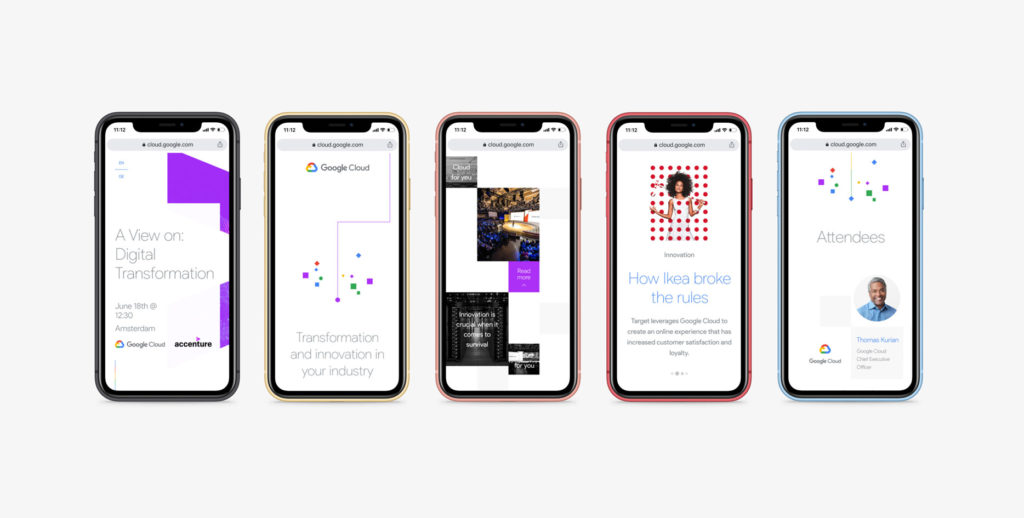
We were commissioned by the Carlyle Group to help them create a digital presence to launch their new Student Living property in the heart of the Liberties. The Carlyle Group manage $217 billion in assets globally and this was an important project for them in the Irish market.
Heyday is located on Carman’s Hall and is only a short walk from most colleges in Dublin. We were asked to take their brand identity and bring it to life through a digital design system which could be used across their website, booking engine, social and advertising.
Cormac MacGowan Head of OperationsSimplicity is the holy grail of business – and it takes a sophisticated and special team to recurrently produce simplicity. With WONDR – there is no overpromising and under-delivering. There is no silly pricing – neither excessive nor low-balled. Instead, there is a fair price for excellent work. If I were asked to capture WONDR in a few words, I’d say simple, elegant, excellence in their field.
Heyday - Carlyle Group
Cormac added…
I’ve worked with multiple web-based businesses over the last twenty years, from banks to property websites, and from game development to national sports teams. I’ve worked with lots of different design agencies.
I have never worked with people like the team at WONDR. The team understand business, they understand customers and the interplay between them. This is the secret sauce to business excellence on the web – and I would not hesitate to recommend the team to anyone.
Simply put – they walk the talk.
The #10YearChallenge has taken the internet by storm, so we’re doing it our way.
Instead of dodgy hairdos and questionable outfit choices, we’re opening the vault to some past work. In 2009, WONDR founder Dermot O’Shea and Creative Director, Oisín Hurst, were key parts of the team that rebranded the GAA.
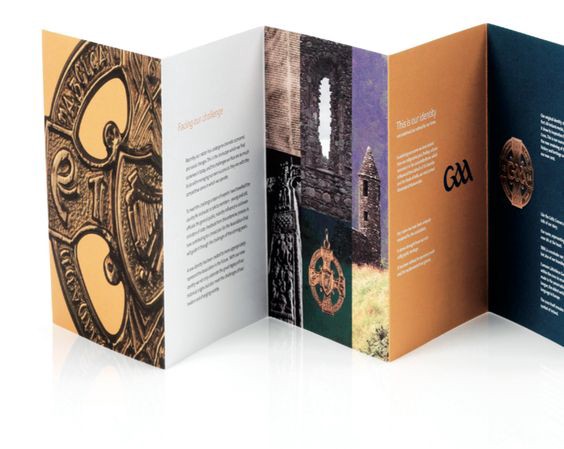
The GAA was founded in 1884 in an effort to preserve and cultivate our national games. Rebranding was also an exercise in preservation, to establish a brand identity that would meet the changing needs of modern Ireland. Ten years on, their work has remained culturally relevant, whilst retaining the deep heritage and storytelling of the GAA and has become an icon of branding.
The GAA is one of the last remaining true institutions in Ireland, what was it like working on such a behemoth?
Dermot: It was remarkable, everyone in the GAA and everyone on the project team felt the weight of expectation to deliver the right outcome. We were working with a brand with rich heritage, so the story was a special one. GAA has a deep history and is culturally engrained in our country. We all really, really cared as a project team and we all trusted one another to do the right thing.
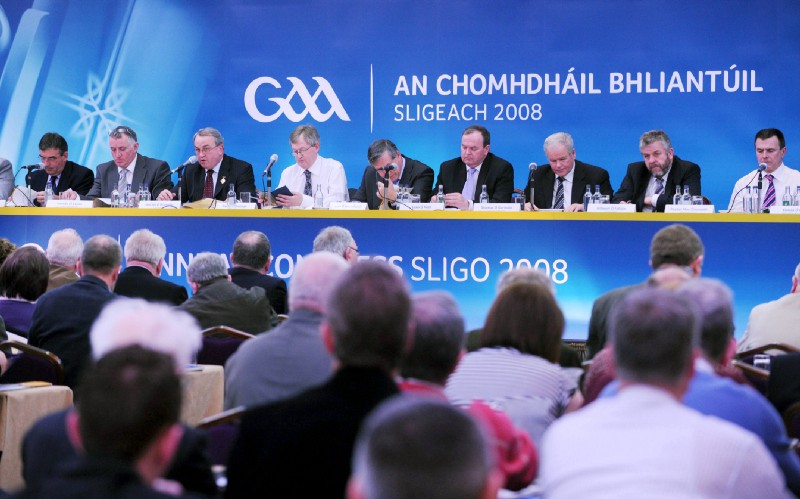
Dermot O’Shea WONDRWe learned a lot about storytelling as a way to sell in the use of the branding. Talking to people in a real way and not highfalutin marketing speak. That still stands to us today when working with brands and clients.
Founder
What challenges did the GAA face and why did they need to rebrand?
Oisín: With everyone from major commercial sponsors to local level GAA kids’ clubs using different versions of the branding there was ambiguity around the identity. Nowhere was the name ‘GAA’ prominent in any of the old branding and the institution was losing ownership of the Championships to corporate sponsors. They needed something that could be owned by the people — from HQ to grass roots clubs, so anyone involved in the GAA could say, “This is us”. We were really conscious of our responsibility to the GAA and to the local clubs to get this right.
No pressure then…..! How did it feel to be tasked to work on such an iconic brand?
Dermot: I didn’t see it as just a brand identity project. It was about the deep heritage of our nation and telling the story of our people. Something to tell your family about, that will be here long after we’re gone. If you do it wrong you will always be disappointed in yourself. We had a great trusting relationship with the client team which gave us the confidence to succeed.
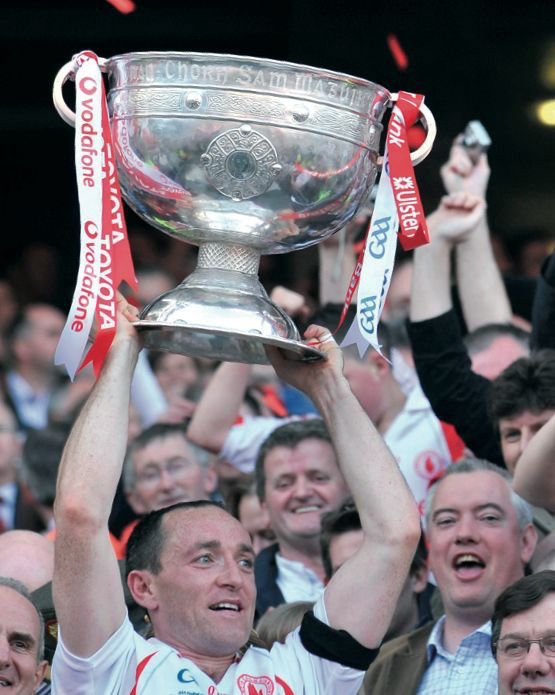
Oisín: It’s a huge responsibility because if you do it right it will never have to be done again. If you do it badly though — well, that can do a lot of damage. You have commercial responsibility to make sure it works well at sponsorship level but also give back something that people can connect to and take ownership of. Ultimately, we understood the heritage and the place for the GAA and were able to make it work.
It was a huge research project, can you tell us about that?
Dermot: The project spanned three years and we reached out to the whole global GAA community, with over 8,000 people interviewed. From the Taoiseach to the grass cutter. Youth workshops were set up all over the country. Sports stars and GAA legends were also consulted. It was so big, our research made the Six One news. How often does that happen on a normal project?
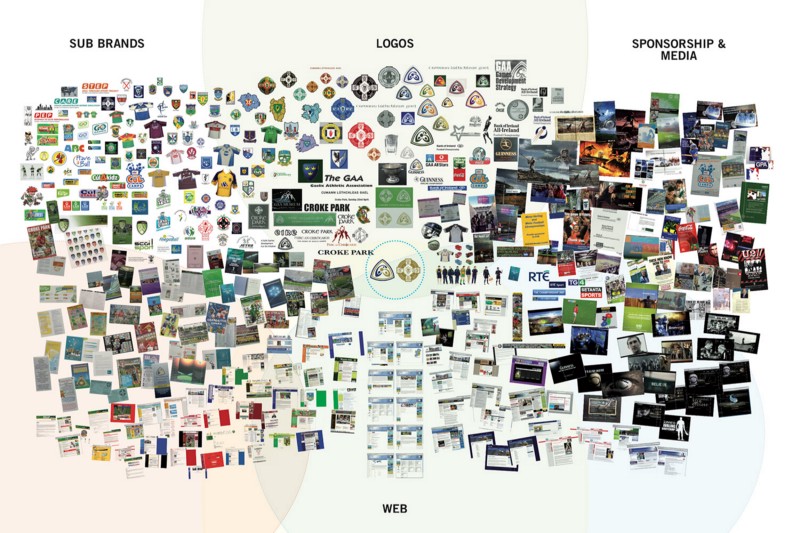
Oisín: Our audit of the brand evolved into an exhibition which ended up being housed in a dedicated hall in Croke Park. Our visual summary board had every artefact of GAA we could find. It was an array of brands connected to the GAA but not united. From championship to club level everyone had a different approach. We had to unify the brand.
Oisín Hurst WONDRIt’s a huge responsibility because if you do it right it will never have to be done again. If you do it badly though — well that can do a lot of damage.
Creative Director
Can you talk us through the logo and what each part represents?
Oisín: There are two parts, the brandmark and the heritage crest. The primary brandmark is the GAA name, uniquely crafted, drawing cultural resonance from Ireland’s calligraphic past.
Oisín Hurst WONDRThe name was uniquely styled, drawing strength from our ancient heritage while being refined to represent youth and games.
Creative Director
Choosing between what is right and what is easy isn’t always a straightforward choice but it doesn’t have to be an either-or situation.
Catching up with Dermot O’Shea (Founder – WONDR) and Oisin Hurst (Director of Creative Brand Strategy – WONDR) and Sarah Jane Lynch, Head of Digital Innovation at Brown Thomas/Arnotts to discuss how making the right combination of choices led to an agile 25 day User Experience project that resulted in a 100% uplift in mobile revenue for the Irish retailer.
When WONDR first started working with Arnotts over two years ago to help them transform the brand for digital there were some serious decisions to be made. The brand’s overhaul for digital required the launch of an entirely new eCommerce site that would align with the brand’s quality credentials, not to mention demanding customer expectations. But what should be done with the existing site in the meantime, particularly on mobile?
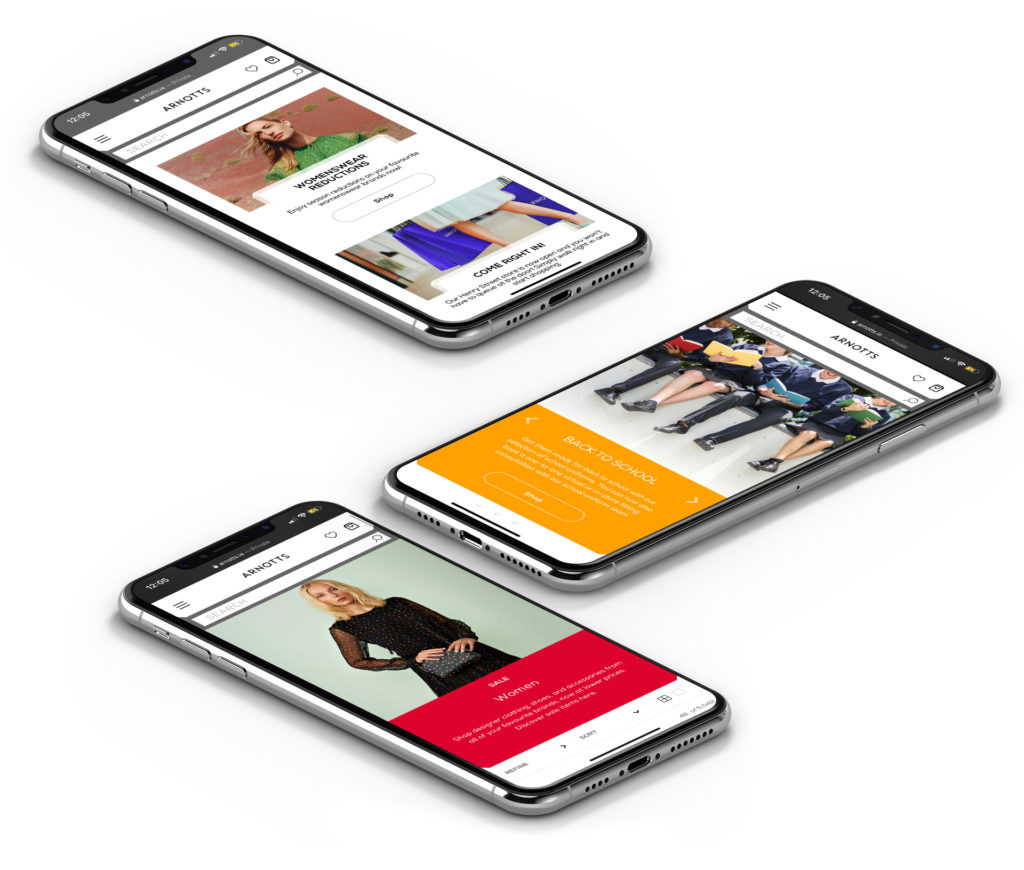
The team at WONDR came up with a plan to both redesign and re-platform the brand while also ensuring key fixes on the existing site would work alongside to significantly boost revenues.
Oisin explains “The initial plan was to look mainly at the new eCommerce website but it became apparent very quickly that there were existing opportunities — ones that would immediately generate more revenue for Arnotts. We looked at it as a win-win — start increasing sales and revenue on the live site, while developing the strategy for the new site in parallel.”
To start, WONDR convinced the Arnotts team that it could apply a “hotfix” approach to optimise the front-end of the platform without having to modify the current platform it was running on. Time is money in retail and this short and medium term approach was essential, especially considering the re-platforming project was due to take several month.
Oisín Hurst WONDRRe-platforming can take a while, but during that time nothing should ever stop for the business. The retailer needs to be able to continue performing user experience changes to keep the business and brand growing
Dermot adds “WONDR already had a very strong working relationship with Arnotts, having worked on a number of projects together — but this time there was the opportunity to tap into a far wider range of techniques and tactics. It was a chance to prove that some of the techniques we planned to deploy in the wider and more ambitious re-platforming project could actually be used right away.
“When you’re working on a project like this it can be very easy to gravitate towards the ‘big ideas” he continues. “Our job was to ensure Arnotts could make the most of the existing platform whilst delivering a mobile and multi-platform brand that would be fit for the future.”
Measuring Impact
WONDR’s brand philosophy is very much in line with delivering results that matter — every idea proposed and decision made by the team was based on doing the best for the customer while also ensuring the brand remains differentiated and distinctive. As a quality retail brand with “experience” as a core principle we needed to deliver on both.”
Sarah Jane Lynch Head of Digital Innovation - ArnottsWe needed to make sure that every piece of work had a clear and demonstrable impact on the bottom line.
She goes on to explain “The team at WONDR spent time analysing site analytics to get a clear picture of what was happening and how to deliver the best site experience and revenue potential. As well as their knowledge of brand building and experience design they really understood that any investment needed to deliver real financial pay-back. Putting strong measurement in place allowed us to measure this against every change made.”
The up-front analysis carried out by the Arnotts and WONDR team clearly helped avoid the costly pitfalls often associated with both hot-fix and major re-platforming projects.
Dermot explains: “Time that you would normally spend in the boardroom coming up with ideas, prepping presentations or polishing minor ideas is better spent working on the actual nuts and bolts of the project itself. It may sound pretty basic, but on projects like this it really is better to sketch out on paper rather than spend valuable time on a Mac polishing detail that may not go anywhere. This project had no time for pontificating or the stroking of crusty beards around a whiteboard — retail moves too fast and is too competitive for that.”
“Once I had a solid system in mind, I quickly moved into prototyping the key journeys that were critical for performance, testing and iterating a real mobile experience.”
“We skipped the usual presentations with exhaustive and quite frankly unnecessary explanations. We were working with a team of “digital doers” — both in WONDR and in Arnotts. It’s amazing what can be achieved by taking a mobile device — the device the customer will actually end up using — and with a savvy, motivated team testing, iterating and implementing quickly.”
A Customer-Centric, Brand-Centric Approach
As soon as ambitious timelines and the right level of investment was agreed the challenge was clearly set. Bridge the gap between the present site and the re-platform and deliver both a long-term and interim customer-centric experience worthy of the Arnotts brand.
Oisin explains the approach. “After we prototyped the ideal mobile experience, we gave our team the painstaking task of redesigning it — significantly, I might add — with CSS and JavaScript amends only,”
We set our best creative developer to lead the team, and his mission was simple: descale as little of the ideal prototype while retaining all mission critical functionality”.
Just improving design and functionality on it’s own though wouldn’t be enough. In the competitive retail category, where many brands are failing to cut-through or disappointing consumers with poor digital experiences, delivering above expectations is no longer a luxury, it’s a necessity.
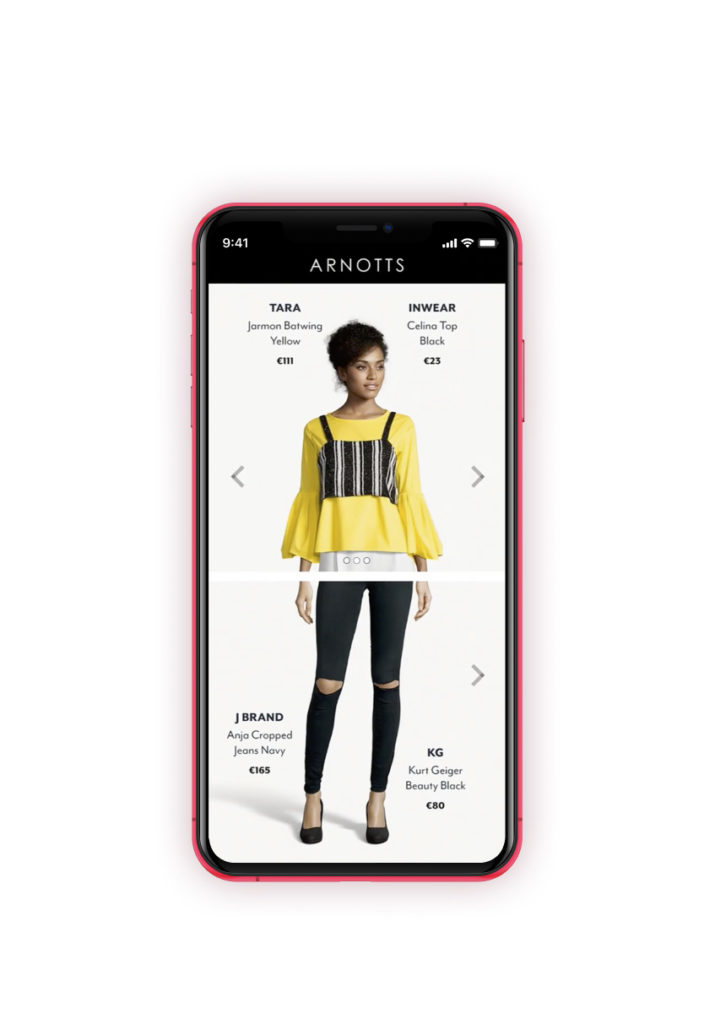
Dermot adds. “We had to start with a basic mobile iteration of their current platform to allow us to build the brand for the future.
The site couldn’t just be a catalogue of products. It had to be a rewarding retail experience online.”
He continues “Anyone who knows anything about retail store design will tell you, it’s very much about understanding customer psychology. So why wouldn’t the same be true online? The big opportunity for Arnotts was transferring this to the digital shopper journey.
Dermot O'Shea Founder - WONDRWe’re living through a cultural and retail revolution and mobile is at the heart of it. For Arnotts, the opportunities are boundless.
Key psychological truths like ‘choice anxiety,’ ‘future memory’ and ‘personal self-doubt’ are all deeply ingrained in shopping behaviour. These important human factors combined with changes in style and culture were taken into consideration during the design process.
User-design is much more than just keeping things simple. It’s about appealing to users on a deep and emotional level while being differentiated as a brand in the mind of consumers.”
Oisin agrees with this perspective. “Designing for retail in digital is much more than optimising opportunistic online transactions. You have to create a true retail destination. A place that people will want too go to because it inspires them, not just helps them carry out pre-considered tasks. People should want to come back to it naturally, like their favourite news site or social media network. That’s the real retail challenge. Brands like Arnotts see it as an opportunity and are already reaping the rewards.
Selling Success
The approach paid off. The project was delivered on time and on budget with the mobile solution delivering significant and immediate impact on revenue.
“It was agile, innovative, cost-effective and financially measurable,” says Sarah Jane, “It was a positive experience to work on too. A real partnership between the teams.”
Oisin adds, “What we’re most proud of is that we proved that properly engaging with a re-platform project, in increments, not just single goals, can bring significant benefits. Taking on a front-end only project is never the ideal solution. Yet for so many businesses in Ireland they can’t afford not to to this.” he says.
“I’m glad we were able to demonstrate in a very tangible way that investing in the proper design and people-centric experience can bring forth much more returns. You don’t have to wait for the big re-platform project to happen. Losing money on a poor site is more expensive in the interim than breaking hot fixes on an existing platform into smaller work streams to create real results from day one.”
So, if time is money in retail, then waiting for the “big new site reveal” without also making what you have work even harder through solid brand and UX thinking could be costing alot of brands more than they realise.
Dermot concludes “We established WONDR to work with progressive, businesses that want to build their brands around people in a digital world. The Arnotts team understood this from the start and we had the backing of the senior team. This is the sort of partnership that creates great work, in the immediate term as well as the long term and as we’ve seen with this project, great return for the business.”